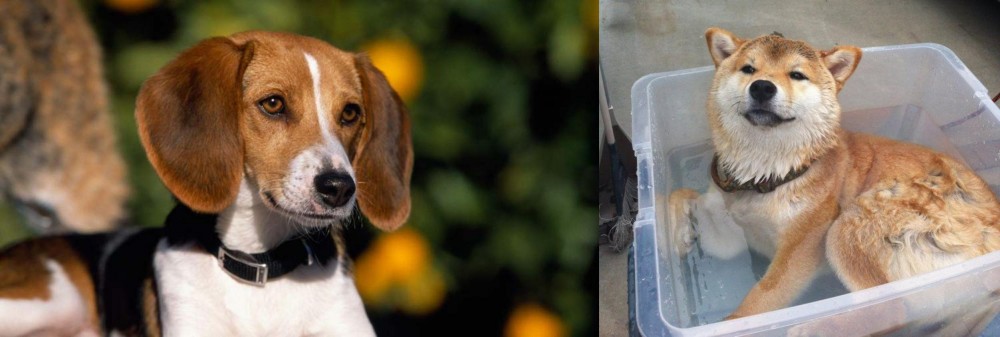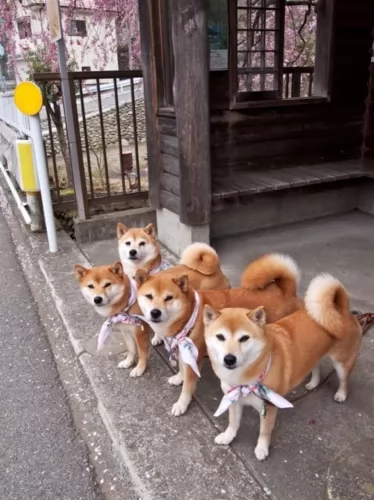 Petzlover
Petzlover American Foxhound is originated from United States but Shiba Inu is originated from Japan. American Foxhound may grow 21 cm / 9 inches higher than Shiba Inu. American Foxhound may weigh 21 kg / 47 pounds more than Shiba Inu. American Foxhound may live 3 years less than Shiba Inu. American Foxhound may have more litter size than Shiba Inu. Both American Foxhound and Shiba Inu requires Low Maintenance.
American Foxhound is originated from United States but Shiba Inu is originated from Japan. American Foxhound may grow 21 cm / 9 inches higher than Shiba Inu. American Foxhound may weigh 21 kg / 47 pounds more than Shiba Inu. American Foxhound may live 3 years less than Shiba Inu. American Foxhound may have more litter size than Shiba Inu. Both American Foxhound and Shiba Inu requires Low Maintenance.
 As a cousin of the English Foxhound, the American Foxhound is a scent hound and bred for hunting. Robert Brooke brought the first hunting dogs to the colonies in 1650. These dogs were the starting point for several American hound breeds including the American Foxhound.
As a cousin of the English Foxhound, the American Foxhound is a scent hound and bred for hunting. Robert Brooke brought the first hunting dogs to the colonies in 1650. These dogs were the starting point for several American hound breeds including the American Foxhound.
For almost 300 years the Brooke family owned and bred dogs from this bloodline.
At the same time that Brooke was hunting with and breeding his hounds, George Washington was given French Foxhounds. These were crossed with the Brooke’s dogs to create the American Foxhound. This breed is said to have been originally bred in Virginia and Maryland.
They are the state dog of Virginia. After Red Foxes were imported or migrated, Irish Foxhounds were brought to American and added into the line, increasing the stamina and speed that today’s dog’s still display.
The American Foxhound was recognized by the American Kennel Club in 1886. Today’s American Foxhound presents in many different lines but are all considered the same breed even though some ay look very different. These strains include the Trigg, Walker, Penn-Marydel, Goodman, July and Calhoun.
 The Shiba Inu hails from Japan and was a dog bred to hunt birds and small game. The dog is one of 6 native breeds in Japan. Today he is essentially a companion dog in both Japan and the United States.
The Shiba Inu hails from Japan and was a dog bred to hunt birds and small game. The dog is one of 6 native breeds in Japan. Today he is essentially a companion dog in both Japan and the United States.
He is actually one of the smaller spitz dogs in the country but known for his boldness.
The first Shiba Inu was imported into the United States in 1954 and was recognized by their Kennel Club in the Miscellaneous Class and also the Non-Sporting Group.
 Given the variety of bloodlines and strains mentioned above, there can be many differences in the American Foxhounds. Because of this most American Foxhounds bred to show are Walkers as they most closely fit the AKC Breed Standard.
Given the variety of bloodlines and strains mentioned above, there can be many differences in the American Foxhounds. Because of this most American Foxhounds bred to show are Walkers as they most closely fit the AKC Breed Standard.
In general, the American Foxhound has long, straight legs and is taller than the English Foxhound. They have a narrow chest and domed skull with a long muzzle.
They have low, wide set eyes that should be dark – brown or hazel, never blue. They have feet like a fox and laid-back shoulders with a curved tail. Athletic and muscled, the American Foxhound is bred to run. They are one of the rarest breeds in the United States.
 The Shiba Inu is a medium sized, athletic dog standing at between 33cm and 43cm in height both male and female and weighing in the region of 6 to 11kg.
The Shiba Inu is a medium sized, athletic dog standing at between 33cm and 43cm in height both male and female and weighing in the region of 6 to 11kg.
He is an agile dog, known for his feline agility. He has the typical spitz dog erect ears and slanted eyes with the tail curling over the back.
The coat is available in a number of colors – cream, red, sesame, black and tan.The double coat is thick and is made up of straight, stiff kind of hair.
This is an intelligent, independent, alert, strong willed dog who has a calm aura about him. He is stubborn too, so it will be best to have him trained or socialized just to make him more amicable to get along with.
As he is a dog that just loves his human family, this training helps him to get along with other dogs too. He is possessive with his human family, wanting to guard them and everything he regards as his territory.
 With a reputation as a docile, sweet dog, the American Foxhound is great with kids and animals. They are gentle and often very shy with strangers. They are strong willed and stubborn especially when training them, so they are not a good first dog. They need an owner who has handled dogs before and knows how to be the pack leader without being angry or mean.
With a reputation as a docile, sweet dog, the American Foxhound is great with kids and animals. They are gentle and often very shy with strangers. They are strong willed and stubborn especially when training them, so they are not a good first dog. They need an owner who has handled dogs before and knows how to be the pack leader without being angry or mean.
The American Foxhound is a scent hound and once he is on the scent it is close to impossible to distract him from it. They have a tendency to ignore commands when they are in this state. A strong owner/leader is needed for this reason. Don’t let him off leash in an unfenced area.
 He is the smallest of several spitz dogs that originated in Japan. He is known for his bold, feisty personality and for being so good natured as well. Other excellent characteristics are intelligence, strong-willed, loyal and loving and he has a calm, confident dignity around him.
He is the smallest of several spitz dogs that originated in Japan. He is known for his bold, feisty personality and for being so good natured as well. Other excellent characteristics are intelligence, strong-willed, loyal and loving and he has a calm, confident dignity around him.
He will get on well with kids and other dogs he has grown up with but he can be a bit aggressive towards dogs he doesn’t know.
Always ensure good exercise. Getting outside and active is important for this dog.
You can certainly benefit from having this wonderful dog in your life as he has some excellent characteristics.
 The American Foxhound, like most hunting dogs does not carry a lot of genetic disorders. But they can easily become overweight and this can cause major problems. Dysplasia of any type had been mostly unknown in this breed, but due to obesity it is cropping up on occasion. Breeders have not, and do not usually screed for any genetic diseases.
The American Foxhound, like most hunting dogs does not carry a lot of genetic disorders. But they can easily become overweight and this can cause major problems. Dysplasia of any type had been mostly unknown in this breed, but due to obesity it is cropping up on occasion. Breeders have not, and do not usually screed for any genetic diseases.
The most devastating health issue the American Foxhound faces is thrombocytopathy. We will go into more detail on this in the Care for Pet section. This is a disease of the blood system, namely the platelets.
 Shiba Inus are generally healthy, but like all breeds, they're prone to certain health conditions. Look out for things such as hip dysplasia, hypothyroidism, bloat, cancer, eye diseases and skin allergies.
Shiba Inus are generally healthy, but like all breeds, they're prone to certain health conditions. Look out for things such as hip dysplasia, hypothyroidism, bloat, cancer, eye diseases and skin allergies.
Skin allergies can come about because of being allergic to food, fleas, too much shampooing and some medications. It can be traumatic for your pet who will sometimes chew and bite to get relief. Treatment varies but get your pet to the vet.
There is pressure in the eye, and symptoms can include vision loss and pain. Glaucoma can be treated with eye drops but sometimes surgery is required.
 Whether feeding a pup, or an adult American Foxhound, you need to be sure the food is high quality and that you don’t overfeed. The Foxhound is happy to eat as much as you give him. They like to eat. Make sure you measure and don’t free feed. Control what they are eating.
Whether feeding a pup, or an adult American Foxhound, you need to be sure the food is high quality and that you don’t overfeed. The Foxhound is happy to eat as much as you give him. They like to eat. Make sure you measure and don’t free feed. Control what they are eating.
For a puppy feed twice, a day – 2 to 3 cups of high quality puppy food. When he becomes an adult feed him once a day with 2 cups of adult food.
As mentioned previously, the American English Foxhound, like most of the hound breeds is a very healthy dog. They do not have many genetic health issues. They do have a risk for thrombocytopathy. This risk is slight, but all owners of American English Foxhounds should be aware of it.
This disease is a circulatory system disease with poorly or non-functioning platelets. Platelets are designed to assist in the control of bleeding and without functioning ones the dog can bleed excessively from just a minor cut or bleed internally from a minor injury. The disease can be treated but you have to notice it first. Depending on how severe the disease is, the treatment will vary. Some dogs will have to be given platelets.
This is a high energy breed that is very active and needs a lot of exercise. They are not good for the first-time owner as they are stubborn and hard to train. They need room to run and get frustrated and out of sorts if they don’t have it. They can live in the suburbs but only with a large fenced yard, an even larger dog park and regular walks. This dog needs a lot of exercise. The simplest thing to do is take him hunting.
 A nice long walk out and about in the neighborhood is good for this dog. Apart from a daily workout, he will love to come running with you or if you go cycling, he will run next to you. He will require exercise every day.
A nice long walk out and about in the neighborhood is good for this dog. Apart from a daily workout, he will love to come running with you or if you go cycling, he will run next to you. He will require exercise every day.
Brushing your Shiba Inu will be required at least twice a week as he is a dog that sheds quite a bit throughout the year. You want to get rid of those loose hairs to keep him looking nice and groomed.
Never pop sugary treats into your pets mouth and avoid feeding him spicy, toxic foods. It can drastically upset his digestion.
You can feed your Shiba Inu commercially manufactured food but it should be the best quality ones. Give him some tasty homemade food too. Simply add into one big pot chicken, brown rice or pasta and spinach, sweet potatoes and carrots. This food can all be chopped up, refrigerated and added warmed up and in small portions to your pets dry kibble once or twice a week.
Try and also give him some raw meat occasionally. Ensure that there is always a bowl of fresh, cool water within his reach.